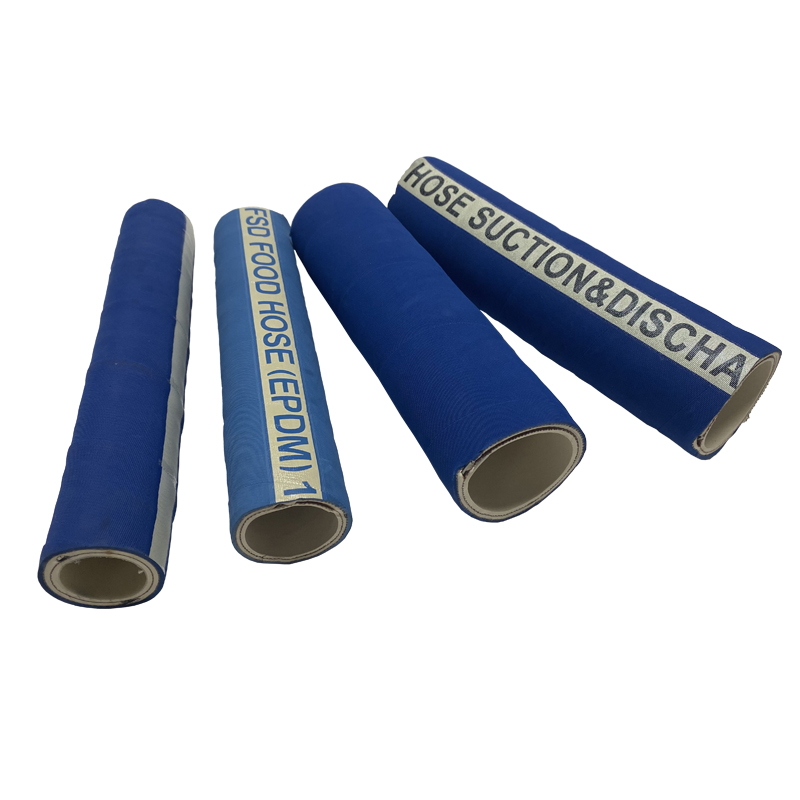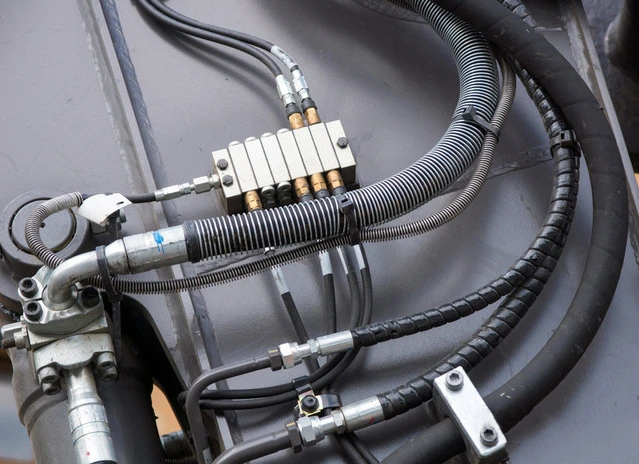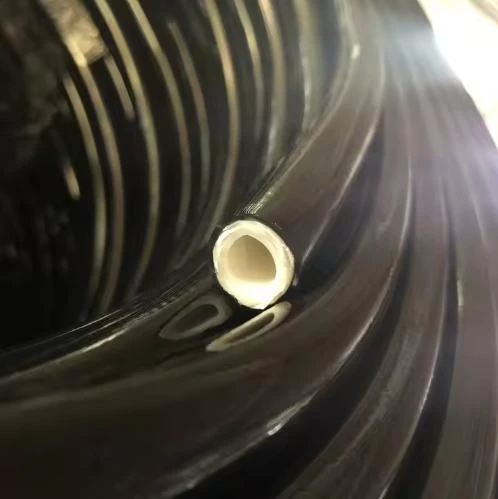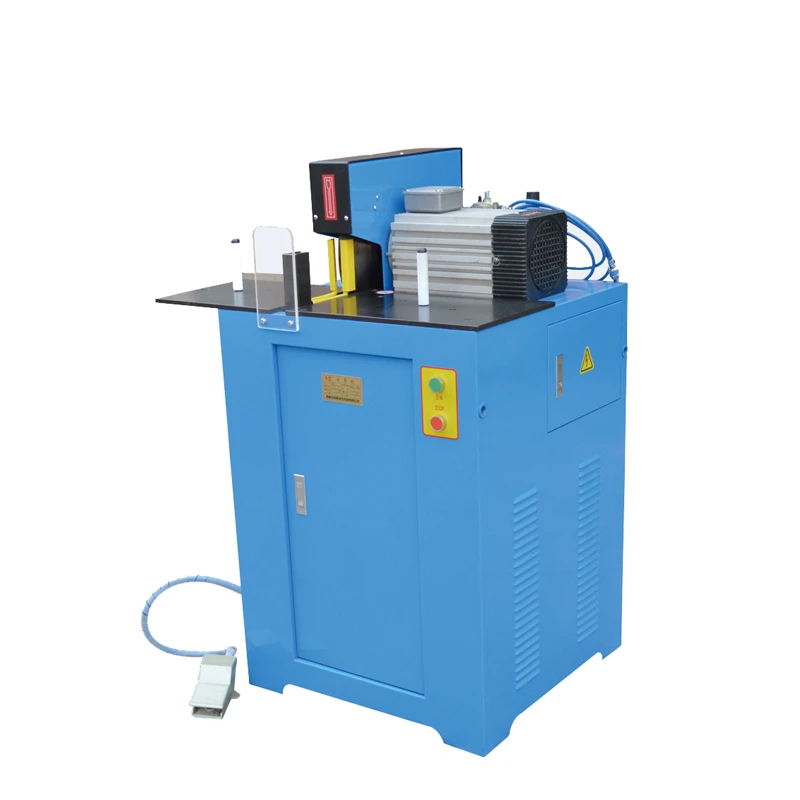Ống dẫn hóa chất
Ống dẫn hóa chất là loại ống được thiết kế chuyên dụng để vận chuyển an toàn nhiều loại hóa chất, bao gồm axit, kiềm, dung môi, dầu và các chất lỏng nguy hiểm hoặc có tính ăn mòn khác. Những ống này được làm từ vật liệu chống ăn mòn, chống hóa chất và chống mài mòn để đảm bảo hoạt động an toàn và hiệu quả. Lớp lót bên trong của ống dẫn hóa chất thường được làm từ cao su tổng hợp, PTFE (Teflon) hoặc các hợp chất chuyên dụng khác có khả năng chống chịu cao với nhiều loại hóa chất. Lớp vỏ ngoài thường được gia cố bằng dây thép bện hoặc lớp vải để tăng độ bền và bảo vệ khỏi hư hỏng cơ học. Ống dẫn hóa chất được sử dụng trong nhiều ngành công nghiệp, bao gồm sản xuất hóa chất, dược phẩm, nông nghiệp, dầu khí và sản xuất thực phẩm, nơi cần vận chuyển các vật liệu nguy hiểm hoặc có khả năng phản ứng cao. Ví dụ, trong ngành công nghiệp hóa chất, những ống này được sử dụng để vận chuyển hóa chất công nghiệp giữa các bồn chứa và thiết bị chế biến, trong khi trong nông nghiệp, chúng được sử dụng để phun thuốc trừ sâu và phân bón. Ống dẫn hóa chất cũng được sử dụng để vận chuyển nhiên liệu và chất bôi trơn trong ngành công nghiệp dầu khí. Khả năng chống lại sự phân hủy hóa học, áp suất và nhiệt độ cao khiến chúng trở nên không thể thiếu trong các ứng dụng đòi hỏi sự an toàn và độ tin cậy cao.
Cần cân nhắc những yếu tố nào khi lựa chọn ống dẫn hóa chất?
Khi lựa chọn ống dẫn hóa chất, điều cần thiết là phải xem xét một số yếu tố chính để đảm bảo ống dẫn hóa chất này phù hợp với ứng dụng cụ thể. Yếu tố đầu tiên cần đánh giá là tính tương thích của vật liệu ống với hóa chất được vận chuyển. Các loại hóa chất khác nhau có thể gây ra mức độ phân hủy khác nhau đối với vật liệu ống, vì vậy điều quan trọng là phải chọn ống chống hóa chất được làm từ vật liệu chống lại các loại hóa chất cụ thể liên quan. Các vật liệu phổ biến cho ống dẫn hóa chất, như ống cao su hóa chất, bao gồm cao su tổng hợp (như EPDM và Nitrile), PTFE và polyethylene, có khả năng chống hóa chất tuyệt vời.
Xếp hạng áp suất của ống hóa chất là một yếu tố quan trọng khác. Đối với các hệ thống có yêu cầu áp suất cao, phải chọn ống hóa chất áp suất cao vì nó phải xử lý được áp suất của hệ thống mà không bị hỏng. Ngoài ra, phạm vi nhiệt độ rất quan trọng vì một số hóa chất có thể cần được truyền ở nhiệt độ cao hoặc thấp qua ống hóa chất.
Tính linh hoạt là một cân nhắc quan trọng khác, đặc biệt đối với ống mềm hóa chất được sử dụng trong các hệ thống đòi hỏi phải di chuyển hoặc uốn cong thường xuyên. Chiều dài và đường kính của ống cũng nên được lựa chọn để phù hợp với yêu cầu của hệ thống nhằm đảm bảo lưu lượng thích hợp và tránh mất áp suất không cần thiết. Các vật liệu gia cố như dây thép bện hoặc dây thép xoắn được thêm vào để tăng độ bền của ống hóa chất và ngăn ngừa tình trạng gấp khúc hoặc sụp đổ.
Cuối cùng, hãy đảm bảo rằng ống hóa chất đáp ứng các tiêu chuẩn và chứng nhận liên quan của ngành, chẳng hạn như các tiêu chuẩn do FDA, ISO hoặc EN đặt ra, để đảm bảo rằng nó an toàn khi sử dụng trong các ứng dụng cụ thể. Bằng cách xem xét các yếu tố này, bạn có thể chọn ống hóa chất cung cấp dịch vụ an toàn và đáng tin cậy theo thời gian.
Những vật liệu nào thường được sử dụng để chế tạo ống dẫn hóa chất và tại sao chúng phù hợp?
Ống dẫn hóa chất được chế tạo từ các vật liệu được lựa chọn vì khả năng chống chịu nhiều loại hóa chất và điều kiện khắc nghiệt mà chúng có thể gặp phải trong các ứng dụng công nghiệp và thương mại. Một trong những vật liệu được sử dụng phổ biến nhất cho ống dẫn hóa chất là cao su tổng hợp, chẳng hạn như EPDM (ethylene propylene diene monome), có khả năng chống axit, kiềm và thời tiết tuyệt vời. Cao su nitrile cũng thường được sử dụng vì khả năng chống dầu, nhiên liệu và dung môi, khiến nó trở nên lý tưởng để vận chuyển các sản phẩm dầu mỏ hoặc hóa chất nguy hiểm. PTFE (Teflon) là một vật liệu phổ biến khác cho ống dẫn hóa chất do bản chất không phản ứng và khả năng chống chịu nhiều loại hóa chất mạnh và nhiệt độ cao. Ống dẫn PTFE đặc biệt thích hợp để vận chuyển axit mạnh, chất ăn da và dung môi có thể phá vỡ các vật liệu khác. Ngoài ra, polyethylene được sử dụng trong một số ứng dụng vì khả năng chống hóa chất và độ linh hoạt của nó, đặc biệt là trong ống dẫn hóa chất dùng trong nông nghiệp và thực phẩm. Để tăng độ bền và độ chắc, ống dẫn hóa chất thường được gia cố bằng nhiều lớp dây thép hoặc bện vải. Các lớp gia cố này ngăn ống bị sập dưới áp suất, đảm bảo độ linh hoạt và bảo vệ ống khỏi hư hỏng cơ học bên ngoài. Sự kết hợp của các vật liệu này đảm bảo rằng ống dẫn hóa chất có thể xử lý an toàn và đáng tin cậy các chất có tính ăn mòn mà chúng được thiết kế để chống lại, đồng thời vẫn duy trì được tính linh hoạt và độ bền trong môi trường khắc nghiệt.
Decoding the Corrosion-Resistant Core of Chemical Hoses: Material Science and Engineering Design
SINOPULSE combines advanced material science with precision engineering to create flexible chemical hoses that excel in transporting aggressive fluids. The ability to resist corrosion hinges on carefully selected inner tube materials, reinforced structures, and protective layers—each element designed to withstand specific chemical challenges. Let’s explore the technical foundations that make SINOPULSE chemical-resistant hoses the trusted choice for demanding industrial applications.
1. Fluoropolymer Liners: The First Line of Defense
At the heart of SINOPULSE chemical transfer hoses lies a fluoropolymer inner tube, typically PTFE (Polytetrafluoroethylene) or FEP (Fluorinated Ethylene Propylene). These materials owe their exceptional corrosion resistance to a unique molecular structure: a tightly packed carbon-fluorine bond (C-F) that is one of the strongest in polymer chemistry. This bond resists breakage from strong acid (e.g., sulfuric acid), strong base (e.g., sodium hydroxide), and solvents (e.g., acetone), making PTFE-lined hoses compatible with over 98% of industrial chemicals. For example, in pharmaceutical manufacturing, PTFE-lined hoses safely transport concentrated hydrochloric acid without swelling or degradation, maintaining fluid purity and hose integrity over years of use.
2. Elastomeric Compounds for Specialized Chemistries
When applications demand flexibility at lower temperatures or resistance to specific chemical families, SINOPULSE employs high-performance elastomers like fluoroelastomer (FKM) or ethylene-propylene-diene monomer (EPDM). FKM, with its cross-linked fluorocarbon structure, excels in resisting petroleum-based solvents and high-temperature oxidizers, making it ideal for aerospace hydraulic fluids. EPDM, conversely, thrives in aqueous environments, providing superior resistance to ketones and steam—critical for wastewater treatment systems where dilute acids and alkalis are common. These materials undergo rigorous swelling tests (e.g., ≤0.5% volume change in ASTM D471) to ensure long-term reliability.
3. Reinforcement Layers: Structural Integrity Under Pressure
Even the most corrosion-resistant liners require robust support to handle high-pressure applications. SINOPULSE high-pressure chemical hoses integrate braided or spiral-wound reinforcement layers, such as stainless steel wire or aramid fibers, to distribute internal pressure evenly. A 304 stainless steel braid, for instance, adds mechanical strength capable of withstanding 500 bar (7250 PSI) burst pressure while remaining non-reactive to most chemicals. This design prevents liner collapse or delamination, ensuring safe fluid transfer in refinery pipelines or chemical reactor feed systems.
4. Protective Outer Covers: Shielding Against External Threats
The outer layer of SINOPULSE chemical hoses is engineered to protect against external hazards like abrasion, UV radiation, and physical impact. Polyurethane (PU) or chloroprene rubber covers offer excellent resistance to cutting and weathering, vital for outdoor chemical transfer in mining or offshore platforms. For static-sensitive environments, anti-static additives in the outer layer dissipate electrical charges, eliminating ignition risks when handling flammable solvents like methanol.
Engineered for Synergy: How Layers Work Together
The true power of SINOPULSE chemical-resistant hoses lies in the synergy between layers: the fluoropolymer liner repels chemical attack, the reinforcement layer maintains structural stability, and the outer cover shields against environmental damage. This tri-layer system undergoes rigorous testing, including permeation resistance (ASTM F739) to ensure minimal chemical leakage and thermal cycling to validate performance across extreme temperatures.
In industries where chemical compatibility and safety are non-negotiable—from petrochemical processing to semiconductor manufacturing—SINOPULSE’s material expertise and engineering precision deliver chemical hoses that redefine corrosion resistance. Trust our solutions to protect your processes, people, and profits, no matter how aggressive the fluid.
Precision Fluid Transfer: The Stringent Demands of High-Purity Chemical Hoses in Semiconductor and Pharmaceutical Industries
In the semiconductor and pharmaceutical sectors, where precision and purity are non-negotiable, SINOPULSE, a leading chemical hose manufacturer, rises to the challenge with specialized high-purity chemical hoses. These industries demand hoses that not only resist corrosion but also maintain the integrity of ultra-sensitive fluids, and SINOPULSE’s engineered solutions meet these exacting standards.
Purity as the Cornerstone
Semiconductor manufacturing, particularly in wafer fabrication, relies on highly corrosive etching agents and ultra-pure water. SINOPULSE’s flexible chemical hoses feature smooth-bore EPDM liners. In pharmaceutical production, where drug safety is paramount, our hoses comply with FDA and USP Class VI standards, guaranteeing that no chemical residues leach into medications during transfer. For instance, when transporting sterile solutions for injectable drugs, SINOPULSE chemical transfer hoses maintain the fluid’s sterility throughout the process.
Controlled Environment Compatibility
Both industries operate in tightly controlled environments. Semiconductor facilities require hoses that can withstand rapid temperature fluctuations during plasma etching and annealing processes. SINOPULSE’s high-purity chemical hoses, reinforced with inert materials like stainless steel braids, retain their structural integrity under extreme conditions without reacting with aggressive chemicals. In pharmaceutical cleanrooms, where particulate matter is strictly monitored, our hoses are designed to prevent outgassing, ensuring that volatile compounds do not compromise air quality or product purity.
High-Pressure Performance with Precision
Semiconductor wet processing and pharmaceutical synthesis often involve high-pressure fluid delivery. SINOPULSE high-pressure chemical hoses are engineered to handle pressures up to 500 bar (7250 PSI) while maintaining precision flow control. The multi-layer construction, combining a corrosion-resistant fluoropolymer inner tube with a robust reinforcement layer, ensures consistent performance without leaks or pressure drops. This reliability is crucial in semiconductor lithography, where even a minor fluid deviation can render an entire wafer batch defective.
Compliance Beyond Standards
SINOPULSE understands that these industries operate under strict regulatory frameworks. Our chemical-resistant hoses undergo rigorous testing, including biocompatibility evaluations and permeation resistance assessments, to meet international guidelines. Whether it’s safeguarding the purity of semiconductor-grade chemicals or ensuring the safety of pharmaceutical formulations, SINOPULSE’s high-purity hoses are the trusted choice for precision fluid transfer in these high-stakes industries.












